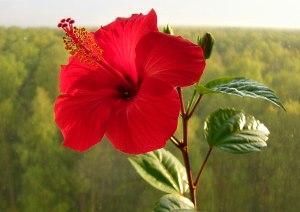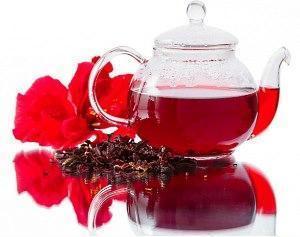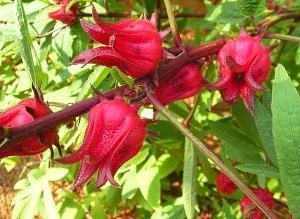Sudanese rose - tea and medicine
 Rosella, Venetian mallow, Pharaonic flower, Sudanese rose are common names for the Hibiscus sabdariff, which we know as hibiscus. Most recently, dried red petals of this beautiful plant began to be imported into our country, and we got acquainted with a drink that has long been known in many countries. In Egypt, hibiscus is the national drink, and is grown commercially in Sudan (the highest quality raw materials), India, Mexico, Thailand, China, Sri Lanka and the island of Java. Dried hibiscus petals, cups and rosants are sold both by weight and packaged in colorful bags or handy teapots.
Rosella, Venetian mallow, Pharaonic flower, Sudanese rose are common names for the Hibiscus sabdariff, which we know as hibiscus. Most recently, dried red petals of this beautiful plant began to be imported into our country, and we got acquainted with a drink that has long been known in many countries. In Egypt, hibiscus is the national drink, and is grown commercially in Sudan (the highest quality raw materials), India, Mexico, Thailand, China, Sri Lanka and the island of Java. Dried hibiscus petals, cups and rosants are sold both by weight and packaged in colorful bags or handy teapots.
Application of the Sudanese rose
In our usual view, aromatic sweet and sour tea is prepared from the red petals of this plant, which can be drunk both hot and cold. Few people know that they use the Sudanese rose not only in the form of tea and decoctions, from its petals you can make jam, jelly, compote, preserves, make tincture or cocktails. Stems, young shoots, leaves and flower petals are added to salads, first and second courses as vegetables. The soaked petals remaining after drinking tea will be useful to eat, since they contain a lot of vitamins, antioxidants and antiseptic substances. This plant gives the body energy, regulates pressure, strengthens the walls of blood vessels, improves vision, and in general in the East it is considered "a cure for all diseases."

- for problem skin of the face, the soaked petals are used in the form of a cleansing mask;
- for swelling around the eyes, use the tea leaves of the Sudanese rose, wrapping it in gauze bags;
- the problem of oily hair can be solved by periodic rubbing of gruel from the petals, which reduces the secretion of sebum.
Growing a Sudanese rose at home
 Lovers of home plants, as well as a pleasant and healthy drink and natural cosmetics, can grow this wonderful flower at home. In garden nurseries and shops "everything for the garden" is unlikely to find rooted cuttings or young seedlings of hibiscus. Therefore, you will have to start growing a Sudanese rose yourself. Subsequently, it will be possible to harvest cuttings from your lignified plant by rooting them in the usual way, i.e. soaking in growth stimulant and planting in soil or sand under a glass jar.
Lovers of home plants, as well as a pleasant and healthy drink and natural cosmetics, can grow this wonderful flower at home. In garden nurseries and shops "everything for the garden" is unlikely to find rooted cuttings or young seedlings of hibiscus. Therefore, you will have to start growing a Sudanese rose yourself. Subsequently, it will be possible to harvest cuttings from your lignified plant by rooting them in the usual way, i.e. soaking in growth stimulant and planting in soil or sand under a glass jar.
The seeds can be ordered on the Internet or, even easier, you can look for them in the purchased package with hibiscus. Soak them, and after the appearance of a delicate sprout, plant them in a small pot, which, as the plant grows, will need to be replaced with a larger container (a tub with a volume of up to 100 liters). The soil for a young shoot needs to be prepared light. The easiest way is to buy a package of ready-made soil substrate for ornamental shrubs, which includes leaf and horse land, peat, sand and humus. As the plant grows heavier and grows (up to two meters in height), it is transplanted into a pot with heavier soil, and if the volume of the pot allows, and there is no way to transplant the flower, then they simply add new soil.
Home Sudanese Rose Care
 The hibiscus sprout is very fond of watering and light, but not direct sunlight, and does not tolerate drafts. When the temperature changes or a draft occurs, the capricious plant drops flowers, which, by the way, will appear 5 years after planting. Feels comfortable at a temperature of about + 20 ° C (in winter above + 15 °, and in summer up to 25 °). With a lack of moisture, the tips of the leaves dry out, and this can be avoided by spraying with water. In an adult lignified bush, if necessary, you can cut the crown, covering the wounds with garden pitch. Caring for a Sudanese rose also consists in feeding the plant, especially during the growth period, with liquid bacterial fertilizers. They should be used in accordance with the directions on the packaging.
The hibiscus sprout is very fond of watering and light, but not direct sunlight, and does not tolerate drafts. When the temperature changes or a draft occurs, the capricious plant drops flowers, which, by the way, will appear 5 years after planting. Feels comfortable at a temperature of about + 20 ° C (in winter above + 15 °, and in summer up to 25 °). With a lack of moisture, the tips of the leaves dry out, and this can be avoided by spraying with water. In an adult lignified bush, if necessary, you can cut the crown, covering the wounds with garden pitch. Caring for a Sudanese rose also consists in feeding the plant, especially during the growth period, with liquid bacterial fertilizers. They should be used in accordance with the directions on the packaging.
The Sudanese rose is susceptible to certain diseases (bacterial cancer, anthracnose) and suffers from pests (aphids, spider mites). In some cases, spraying and treatment with special preparations or the physical destruction of insects helps, but in especially difficult cases the plant dies.
Thanks for the interesting and informative article. I really love Sudanese rose tea. I first tasted it about 10 years ago, to me it tastes like a cherry compote. I didn't know, however, that hibiscus helps fight oily scalp, relieves swelling around the eyes. I would very much like to grow it at home. After reading all the recommendations in the article, I will definitely try. Or maybe someone has personal experience in growing a Sudanese rose?
I brought tea from Egypt, found buds there, I think let me plant it. The seeds did not germinate in the cloth. I planted it immediately in the ground in August 2014. I left for a week, and when I arrived, the stems of 10 cm had already grown (moreover, I planted 5 seeds, 5 and rose). Flowers are on the windowsill, the side of the sunrise (so there is little light for them). It blows from the window and the leaves turn yellow. Watering every day. But what a miracle - I did not wait 5 years for flowering. Now 03/08/2015 3 bushes are covered with rosebuds, and 07.03. one bud has blossomed.
Pavel, tell me, please, in what land did you plant and fertilize?
Hello. Thanks for the info. Recently, I found hibiscus seeds from a package of hibiscus and soaked and planted, 15 days have passed, they are growing rapidly, 2 leaves have appeared. They stand on the east side.
Irina K. 2 years ago visited Egypt with her husband. Returning from Luxor, they bought hibiscus from the local Egyptians. There were a lot of seeds in the package. 2 years later I decided to plant them…. Simple soaking did not work and I went for some trick. I took a leaf of scarlet, cut it from the side and put the seeds there. Aloe is considered the strongest biostimulant. The seeds sprouted on the 4th day. There were 11 of them. I took the land from the store, as for tomatoes. The seedling turned out to be good. 3 I gave it to an employee, and 8 I planted between the beds, at the end of each garden bed. She did not cover anything, she only watered and fed with a solution of Baikal-EM1 (1 tablespoon of solution for 10 liters of inlet). Baikal-Em1 are effective microorganisms. Leaves are carved, sour, stem and veins of beetroot color. Buds appeared at the end of July, in each internodes (many). They resemble the shape of a bell. One blossomed in a light pink color (August 30). On August 31, it turned dark pink, but closed (it became cold outside). Tomorrow, that is, September 3, 2016 I will go to the dacha to see how feel my pets ... Other hibiscus hibernate (leaving 10cm, the rest is cut off). They cover like roses. I don’t know how the hibiscus will behave…. I will leave something in the ground, something at home. Herbaceous bushes, the trunk too. The leaves were put in a salad, stewed with meat. I'll try to roll it up in a jar. Excellent seasoning, which reminds me of sorrel in taste. Go for it, try it….
Hibiscus is a perennial plant that grows as a large shrub, and the Sudanese rose, or as the botanists call it rosella, or hibiscus sabdariffa, is an annual herb of the Malvaceae family. In the photo, perennial hibiscus is not terry. Absolutely not like the herbaceous bush from which we drink tea.
I don’t know how grassy he is, he planted karkade seeds directly from Sudan in bulk purchased.
The bushes have grown more than a meter, and in my view it is the bushes, not even a half-shrub, and even more so grass. They began to bloom. But later in the winter I lost them.
Now, of course, you can afford any light you choose from those available on the market. And then it was a little harder to embody
I found seeds in a bag of tea. I planted five and they all sprouted. There is nothing to do with the hibiscus plant. In three months, they grew by 25 centimeters in each leaf sinus by a bud. But for some reason the buds turn yellow. I'm waiting for it to be quite warm to plant on I wanted to post a photo, but it doesn't work.